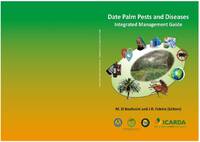Date Palm Pests and Diseases: Integrated Management Guide

Authors:
Date palm (Phoenix dactylifera L.) is a major fruit crop in the Middle East and North Africa (MENA). The crop’s tolerance to high temperature, drought, and salinity makes it suitable to the harsh environment in the MENA region. Date palm is currently cultivated in nearly 30 countries on the Asian, African, American, and Australasian continents. There are over 100 million date palms worldwide, of which 60% are in the MENA region. Dates provide rural livelihood security to millions of farmers in the arid regions of the world and are of significance to human nutrition, due to their high content of essential nutrients. The world production of dates has increased from 1.8 million tons in 1962 to over 8.0 million tons at present.
Climate change due to global warming has impacted the flora and fauna worldwide, especially in arid zones. This has significantly changed the pest and disease complex of date palm, calling for the implementation of climate resilient pest and disease management programs. It is estimated that over 50% of the date palm plantations are young, below the age of 20 years offering an ideal situation for pests like red palm weevil, Rhynchophorus ferrugineus Olivier to establish and proliferate. On the other hand, in older plantations, where irrigation may be scarce the long horn beetle, Jebusea hammerschmidti Reich is emerging as a challenge. Bayoud is considered the most serious disease of date palm, especially in Morocco and Algeria, where it has destroyed millions of date palms. Another major disease that is fast emerging is Al Wijam in the Gulf region.
Integrated Pest Management, which has an ecological base, focuses on the use of a wide range of pest control options instead of relying only on the use of pesticides. Developing or implementing an IPM program for a crop involves a systematic application of knowledge about the crop and the pests involved. This guide on date palm IPM is a comprehensive overview on the biology (life cycle, damage, losses, geographical distribution, and host range) and management of major pests and diseases of date palms, besides addressing issues related to farming practices in relation to pest and disease management.
This guide also addresses important topics of date palm IPM programs, including the concept of threshold-based pest management. Furthermore, this publication highlights the guidelines and methodologies for pest surveillance, design and analysis of common IPM experiments, application of geoinformatics in developing distribution and risk maps for the management of pests and diseases.
The IPM program on date palm should be based on real, field-specific situations and feasible solutions. This IPM guide on date palm offers a sustainable and scientific approach to managing date palm pests and diseases. The approach proposed in this guide to control major pests and diseases of date palm is flexible enough to accommodate the changing demands of agriculture, commerce, and society and will be useful to farmers, pest managers and others involved in the date palm sector.
The publication of this guide is a result of the fruitful collaboration on date palm production system for the last decade between the Gulf Cooperation Council (GCC) countries, Abu Dhabi Food Control Authority (ADFCA) and the International Center for Agricultural Research in the Dry Areas (ICARDA). This book also benefited from the results of the IFAD funded project in Iraq on “improved livelihoods of small farmers in Iraq through integrated pest management and organic fertilization”.
